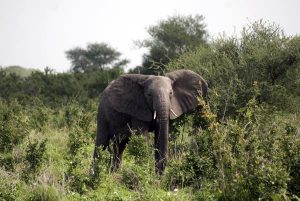By the time you finish reading this article, another elephant will have been killed by poaching in Africa for its ivory. Every 20 minutes, every single day, another elephant is massacred.
In 2014 alone, 40,000 elephants and over 1,200 rhinos were killed by poachers. If this rate continues, that will lead to both of these majestic creatures becoming extinct within ten years if things don’t change. Unfortunately, it’s getting worse and rangers are losing the war against poachers. Criminals are becoming increasingly militarized in their tactics, and efforts to stop them have had little success.
There are conservation groups around the world that believe that the answer to poaching lies with modern technology and this is partially true. However, huge amounts of money are being wasted on inappropriate technologies which simply do not address the problem, are too expensive, too hard to maintain and too difficult to use in the African bush – at night, when the poachers strike. Part of the answer may lie with using unmanned aerial vehicles (UAVs), better known as drones.
Using UAV’s, or drones have proven to be useful in other areas. Not only does our military use UAVs in Baghdad to find IED bombers, they’ve also proven useful to identify other areas in Africa where much medical support is needed. Now, they can be used to find poachers on the continent.
Recently, African Parks have embarked on an unusual high-tech experiment, calling in a drone team from South Africa. With funding from the World Wildlife Fund, including a $5 million grant from Google, drones are being tested in areas that are known for high occurrences of poaching. This is the first systematic evaluation of their potential to combat poachers.
As more drones are used to find and contain the poachers, UKA is on the cutting edge of designing precision lenses for these types of drones. At UKA, our entire process is done in house, therefore, you can rest assured that from the original design to finished product will meet or beat your expectations.
However, the key question is: where to fly the UAV? Africa is much too big to be simply launching UAVs into the sky with the hopes of finding anything. That’s where the math and science comes into play.
By using very high resolution satellite imagery, mathematics and algorithms to determine where the animals are on a given night and understanding their movements and behavior, rangers may have a much higher likelihood of catching the poachers. With this knowledge, UAV’s can then be flown in the African night sky with infrared cameras to alert authorities on where the poachers are coming from to attack the prey.
The poaching of the African wild-land animals needs to come to an end. Putting drones into the air give the park rangers and other wild-life organizations the upper hand in the fight.
Universe Kogaku designs and manufactures optical lenses for UAV’s, security, high tech and electronic applications. We stock 1000’s of standard lens assemblies and can custom design a solution for scanners, CCTV, CCD/CMOS, medical imaging, surveillance systems, machine vision and night vision systems.